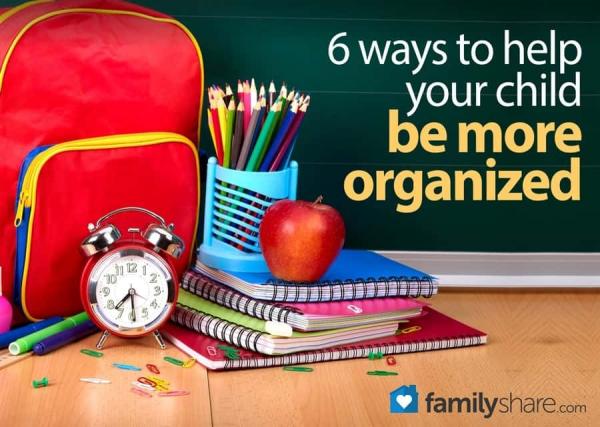
Some of the most frustrating words for a mother to hear are "Mom, I can't find ..." When you are trying to get out the door on time for school, practice or work it is even more frustrating. Being disorganized is not only frustrating, it can affect performance at school, cause tardiness, and create a sense of being overwhelmed.
Constantly a work in progress at our house, organization is a skill that is important for children to be successful in life. Also, what works for one child may not be effective for another (hence the continual evolvement in our home). The following basic tips have helped us overcome some of that frustration and helped our children to reach a higher level of success.
Everything in its place
One of my husband's favorite sayings is "Everything has a place, and everything in its place."� When backpacks, sports equipment and music books don't have a regular home, they will always be difficult to find. Designate a home for everything - a hook by the back door or the garage for backpacks and sporting equipment; a basket by the piano for music books, a basket for shoes.
Include your child in the planning and implementing
In Donna Goldberg's book, The Organized Student, she suggests, "Before you begin, talk to your child about the process and purpose of organizing."� Without a vested interest and an understanding of what is going on your child will have a hard time adapting or implementing a new plan.
Focus on one issue at a time
This may be difficult to do. But if you try to change how a child does everything all at once they will become more frustrated and give it up as being hopeless. Decide which area needs the most immediate focus - school, for example - and set out to organize just that. It takes about 21 days to establish a habit, so give it a few weeks before setting out to tackle another issue.
Establish routines
Children like routine. They like knowing what to expect and what is expected of them. Our youngest was struggling with adapting to kindergarten. We decided to create morning and evening charts that he could check off each responsibility he had, such as get dressed, brush teeth, etc. We laminated these and put them on a clipboard. Then we gave him a dry erase marker so he could take responsibility for completing the tasks.
Review your family schedule
Letting children know what is going to happen the next day, that week, or during the month gives them a clearer sense of what is expected of them. This may need to be a daily review where you go over the schedule for the next day, or a weekly one. We post on a white board what will be happening each day. We also have a weekly calendar review on Sunday evening, so we all know who needs to be where and when.
Labels
When my oldest sons were younger, we were teaching them to put away their own clothes. I made laminated labels with the word and picture of different items of clothes. I taped these on their dresser drawers so they could see where to put each item.
When our second son was struggling with school organization, we printed labels for each folder and notebook so he knew where everything should go while at school and when he completed homework at home.
Remember that organization is a work in progress. Don't nag your child when you put a new system in place. Give it time to see if it is going to work. If it doesn't, go back to the drawing board and create a new plan with them. The point is to help them become independent and develop personal responsibility for themselves and their belongings. Your job is to help them reach this by working with them to create a system of organization that works for them.

